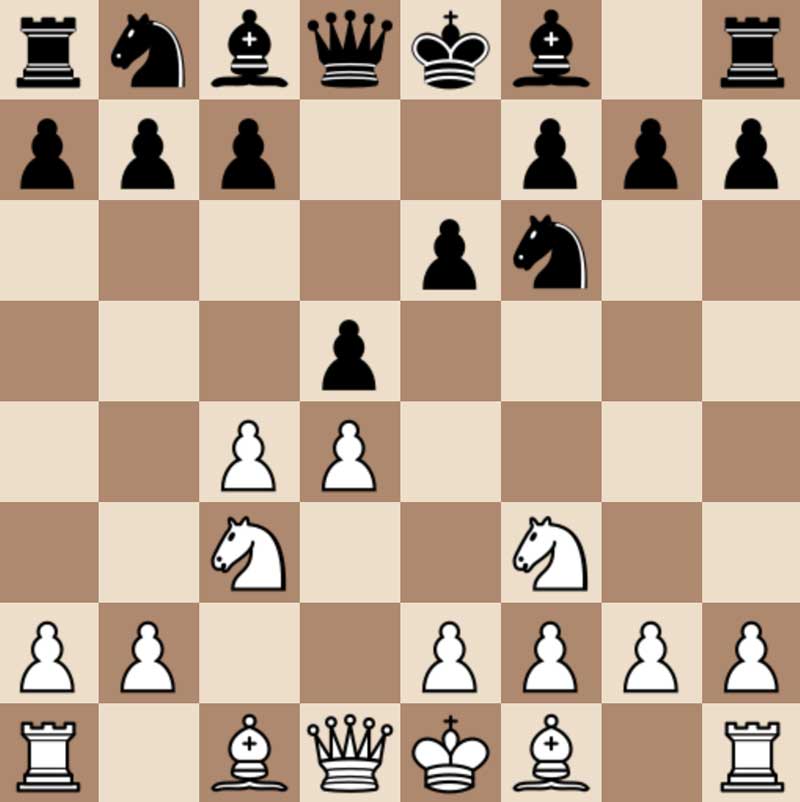The Queen’s Gambit Declined is one of the most respectable defenses that is employed at the top level of chess.
In fact, in the 2018 World Championship Match, Fabiano Caruana employed it with the Black pieces to neutralize Carlsen’s opening preparation. In some cases, he even managed to gain a slight edge, pushing the world champion to defend his position with White.
Thanks to that, this opening is only becoming more popular everyday. At the same time, it’s important to learn how to play against the Queen’s Gambit Declined with the White pieces.
In this article, we will equip you with one of the main ways to play with the White pieces in this opening.
Table of Contents
White’s 3 Best Setups In QGD
After 1.d4 d5 2.c4 e6(The Queen’s Gambit Declined), White has many different setups to choose from. Here are the main and best ones.
- 3. Nc3 Nf6 4. Nf3 – Queens Gambit Declined Mainline
- 3. Nc3 Nf6 4. cxd5 – Queens Gambit Declined Exchange Variation
- 3. Nf3 Nf6 4. g3 – The Catalan
Depending on your preference, you can decide which one to employ.
3. Nc3 Nf6 4. Nf3 (Mainline)
This is the most popular way for White to play in the QGD. However, at the same time this demands a lot of preparation.
For instance, Black has many different options here to play 4…Nbd7, 4…c6 4…Be7, each having a separate theory of its own.
While it’s perfectly fine to play this line, we won’t be covering it here because of the flexibility of the options for both the sides.
3. Nf3 Nf6 4. g3 (The Catalan)
The Catalan is another powerful weapon for White in the QGD. A lot of top Grandmasters employ this line, one of the biggest being Shakhriayr Mammedyarov.
White fianchettos their bishop to g2, keeping things solid and compact. Black often has a tough time cracking White’s setup.
However, White has to be skilled in exploiting minor weaknesses. Very rarely tactics popup in such positions. Playing this requires some deep understanding of positional chess.
Now let’s check the final option, the one that we will cover in more detail.
3. Nc3 Nf6 4. cxd5 (Exchange Variation)
The exchange variation is one of the popular ways to meet the QGD with White pieces. After
4…cxd5, we recommend
5.Bg5
This is the key move. Let’s understand what’s going on in the position. This is very important as this forms the foundation of our opening strategy.
- White is threatening to take Bxf6 to ruin Black’s structure on the next turn.
- Despite opening up the diagonal for the c8-bishop after 4…cxd5, the problem for Black remains where to develop that bishop. This is the main problem Black is trying to solve and White’s play is based around that.
- White will often try to control the f5 square with Bd3, Qc2 etc.
- We have a Carlsbad structure where White often tries to advance their pawns on the queenside.
Black plays…
5…Be7
Note that 5…Bf5 instantly isn’t possible because of 6.Bxf6 and Black is forced to capture 6…gxf6 in order not to lose the d5-pawn.
After 5…Be7, play continues
6.e3 c6 7.Bd3 0-0 8.Nf3 Nbd7 9.Qc2
If you notice, both sides are completing their development before doing anything concrete. That’s another feature of playing this opening.
9…Re8
Vacating the f8-square for Nd7.
10.0-0 Nf8
And now, we play the prophylactic move
11.h3!
No rush! Remember, we talked earlier about Black’s main problem? It’s the c8 -bishop. With 11.h3, we accomplish 2 things. First of all, we take away the g4 square from Black’s c8-bishop. Second, we create an escape square for our king.
Here are some typical middlegame plans for White in this position.
- If Black doesn’t play …Ng6 in time, we can jump to a central square with Ne5. This is often followed by f4, Rae1 and in some cases g4 with aggressive intentions on the kingside.
- White can also play on the queenside by preparing b4, followed by b5. For this reason, the first player diverts the e7-bishop with Bxf6 Bxf6 and pushes their pawn to b4.
The resulting position is very rich and complex, where the side with a superior positional understanding has the edge. Planning and maneuvering pieces becomes very important here. Play this variation a few times with your friends or online to gain experience in it. This will help you develop a feel for the position.
Play The Exchange Variation Decline as a Beginner
White has more than 1 way to play in the Queen’s Gambit Declined. The Catalan variation and the mainline with Nf3 and Nc3, are quite complex if you are just starting out. Therefore, we recommend playing the exchange variation with 4.cxd5.
Remember, White’s main strategy revolves around not allowing Black to develop their c8-bishop to active squares like f5 or g4. While there are some options that Black can try, the underlying strategy is about solving the problem of development of their c8-bishop. If they can solve that problem, they will most likely equalize. This is where the battle will be fought.
We also would like to thank the authors of the books we referred to during our research.
Strategic Chess Opening Repertoire for White by John Watson
Grandmaster Repertoire 1.d4 by Boris AvrukhWe hope you found this article insightful. Do you have any other suggestions to play the Queen’s Gambit Declined with White? Let us know in the comments below.


